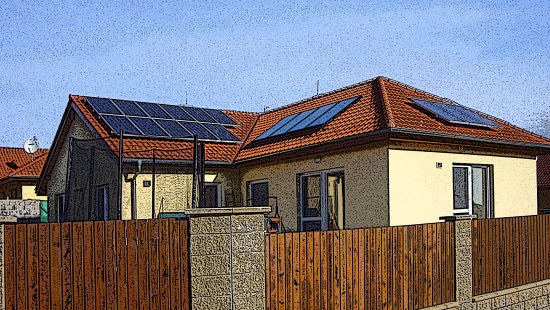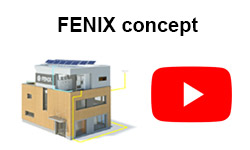Electric heating in an energy-saving detached house – part I.

A project to create an energy-saving house with an electric floor and ceiling heating system resulted in a very economic and comfortable home for the user
Expert, author and investor in one
The aim of the REP-HOUSE design project, an energy-saving house in Moravany u Brna, which was created through the cooperation of the author of the project with Fenix Jeseník (the largest domestic producer of electric heating systems and one of the REP-HOUSE project partners) is to demonstrate the capabilities of the contemporary building industry in the field of low-energy and passive structures. The author of the project is an associate professor at the Faculty of Civil Engineering of Brno University of Technology. As early as during his doctoral studies, he was engaged in research in the area of energy saving in structures and the possibilities of increasing the thermal resistance of masonry blocks. He lectures on the topics of the thermal protection of buildings and low-energy structures at the Faculty of Civil Engineering of BUT and thus it is logical that his own family home could function as a small ‘laboratory’ where he can try things out for himself from the position of a common investor – i.e. starting from the design stage and moving through the execution of the building up to its eventual utilization, including all the consequences of his decisions. From the beginning, it was therefore his main aim as the author of the project to design a house with internal thermal comfort both in the winter and summer seasons and simultaneously with an emphasis not only on the acquisition costs but mainly on the lowest possible operating costs.
Comparison of acquisition and operating costs for the heating of LEH and passive houses
One of the characteristic features of low-energy and passive houses is their low energy consumption due to heating, and this factor prompted the author of the project carry out a thorough analysis with the aim of choosing the most suitable heating system for his house. Even for standard structures, it cannot be stated generally and unequivocally which heating solution is the most advantageous for the structure; this is even more complex in the case of low-energy buildings, as they have only been on the market for a relatively short time.
The first step was therefore the comparison and evaluation of investment and operating costs as far as heating, the heating of water and electricity consumption are concerned – this was done by comparing the two main energy sources used in the Czech Republic: natural gas and electricity. It was necessary to make this comparison in a comprehensive manner, i.e. including not only heating costs but also electricity and the heating of water for the household.
The REP-HOUSE in Moravany u Brna
It is a single-level house with a saddle roof (atrium house) with large south-facing windows and a total floor area of 130 m², with a storage area of 30 m² in the attic. The outer masonry was designed as a sandwich of brick blocks with a thickness of 300 mm, and to provide thermal insulation the author decided on polystyrene EPS façade insulation with a thickness of 300 mm. Thermal insulation of both the ceiling and floor structure was included in the design project; specifically, the ceiling was insulated with PUR boards to a total thickness of 300 mm, and the floor with 150 mm polystyrene EPS.
Based on the design project, the yearly energy consumption for heating and the heating of warm water was determined as 4200 kWh and the electricity consumption as 2500 kWh for the reference house. For the calculation of operating costs, specific local conditions had to be considered according to which the appropriate tariff was selected. (natural gas: Jihomoravská plynárenská a.s. – local gas distributor, household category, yearly consumption within the range of 1.89 to 9.45 MWh/year, electricity: E.ON Energie, a.s. – local supplier, household category, circuit breaker over 3x20 A to 3x25 A inclusive). The results of the calculations are shown in the table.
Heating using electricity appears to be more advantageous
When selecting electric heating for a building whose parameters closely approach those of the LEH category, it is a basic fact that the most important criterion is no longer the price of the energy itself – the acquisition costs, ‘maintenance costs’ and the durability of the heating system and its components have a far more important influence. Energy consumption for heating in such buildings is so low that e.g. in the case of heat pumps, the operating life of the equipment will end before a return on investment is gained, even though such pumps can produce heat in the cheapest way.
Also not to be forgotten is the fact that the low tariff provided for electric heating also applies to all other home appliances, while in the case of gas heating, the tariff for electric appliances is several times higher. The author’s analysis showed that while the price of heating using electrical energy is higher than that of gas, after adding the operating costs of other appliances in the household, the operating costs were not only equal but in the case of electric heating there is even a saving of approx. 1 thousand CZK (at the current price).
The current trend of modern households being highly equipped with electronic and electric appliances will thus only amplify the advantage of the low tariff for electric heating.
Calculations confirmed that this design with its electric heating system will be very economical; the author of the design project also appreciated the variability of the heating system, the accuracy of regulation as well as the high user comfort. Thermal comfort throughout the house will thus be provided by FENIX Jeseník products – for the REP-HOUSE, floor heating via ECOFILM foils was chosen for most areas, and ECOFLOOR heating mats were fitted under floor tiling in the bathrooms and the kitchen. In two rooms, the author designed ceiling heating using ECOFILM C foils. Of course, this is all with BMR central regulation.
You can find the second part of the trilogy here…
You can find the third part of the trilogy here…





